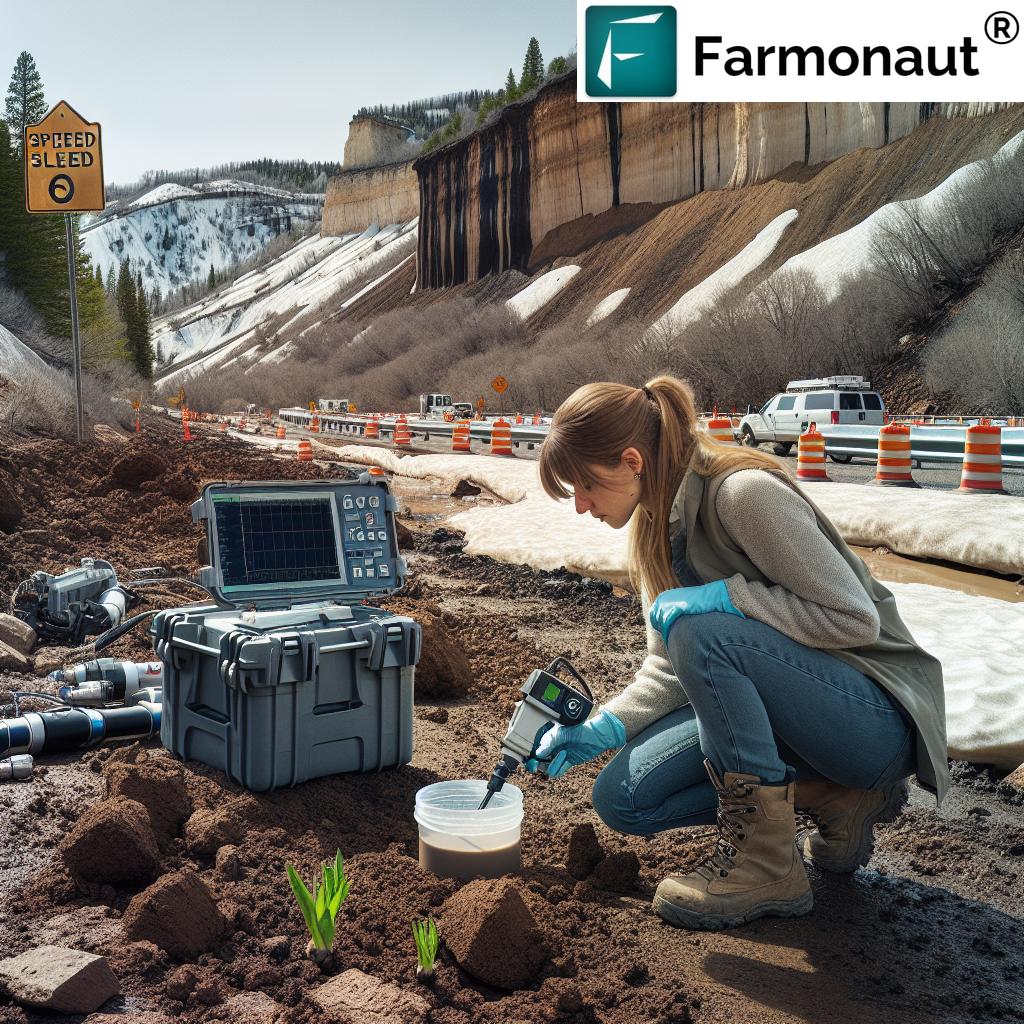Mastering Utah’s Mudslide Menace: How Drones and Geotechnical Analysis Enhance Highway Safety in Red Narrows
“Utah’s recent US-6 mudslide near Red Narrows prompted a swift closure lasting less than 60 minutes, showcasing efficient emergency response.”
In the heart of Utah’s rugged terrain, where nature’s raw power meets human ingenuity, we find ourselves facing a formidable challenge: the ever-present threat of mudslides. As representatives of Farmonaut, a company at the forefront of agricultural technology, we understand the critical importance of environmental monitoring and risk mitigation. While our focus is primarily on crop health and farm management, the recent events in Utah’s Red Narrows area highlight the broader implications of soil dynamics and environmental factors that affect both agriculture and infrastructure.
The recent Utah mudslide on US-6 near the Red Narrows area serves as a stark reminder of the delicate balance between human infrastructure and natural forces. This incident, caused by a perfect storm of thawing snow, moisture accumulation, and the presence of natural springs, prompted swift action from transportation officials. The efficient response, resulting in a road closure lasting less than an hour, showcases the remarkable preparedness and expertise of Utah’s Department of Transportation (UDOT) in managing such unpredictable events.

Understanding the Red Narrows Mudslide
The mudslide that engulfed US-6 near milepost 193 around 8 p.m. on a Tuesday evening was a testament to nature’s unpredictability. Wyatt Woolley, senior communications manager with UDOT Region Three, aptly described the situation: “This is just one of those things where nature says, ‘hey, I’m boss, and we’re going to have a slide come through here right now.'”
The causes of this mudslide were multifaceted:
- Natural Springs: The area is known for its natural water springs, which contribute to soil saturation.
- Spring Runoff: Melting snow from higher elevations increases water flow and soil moisture.
- Thawing Snow: As temperatures rise, the thawing process releases additional moisture into the soil.
- Soil Saturation: The combination of these factors leads to oversaturated soil, prone to movement.
Fortunately, no injuries or vehicle damage were reported in this incident. However, it serves as a crucial reminder of the importance of vigilance and preparedness in areas prone to such natural hazards.
UDOT’s Swift Response and Prevention Measures
The Utah Department of Transportation’s response to the mudslide was nothing short of impressive. Their quick action and efficient clearing of the road within an hour demonstrate the department’s commitment to public safety and minimal disruption to traffic flow.
UDOT employs several strategies to mitigate the risk and damage of mudslides and rockfalls:
- Ditch and Barrier Maintenance: Regular upkeep of drainage systems and protective barriers helps channel water and debris away from roadways.
- Daily Monitoring: Maintenance crews keep a vigilant eye on high-risk areas, identifying potential trigger points for slides.
- Geotechnical Analysis: Expert teams assess soil stability and geological factors to predict and prevent potential hazards.
- Drone Technology: The use of drones for aerial assessment provides a comprehensive view of affected areas, enhancing safety and efficiency in hazard evaluation.
While it’s challenging to predict every potential mudslide or rockfall, UDOT’s proactive approach significantly reduces risks and enhances overall road safety.
The Role of Drone Technology in Mudslide Assessment
In the aftermath of the Red Narrows mudslide, UDOT’s geotechnical team deployed drone technology to assess the area thoroughly. This innovative approach offers several advantages:
- Safety: Drones allow for close inspection of unstable areas without putting personnel at risk.
- Comprehensive Coverage: Aerial views provide a broader perspective of the affected terrain.
- Rapid Assessment: Quick deployment and real-time data collection enable faster decision-making.
- Precision: High-resolution imagery helps identify subtle changes in soil and rock formations.
The use of drones in this context aligns with Farmonaut’s approach to leveraging technology for environmental monitoring. While our focus is on agricultural applications, the principles of using aerial imagery for analysis are similar. For instance, our crop plantation and forest advisory services utilize satellite imagery to monitor vegetation health and soil conditions, which can be crucial in identifying areas at risk of erosion or landslides in agricultural settings.
The Importance of Geotechnical Analysis in Road Safety
Geotechnical analysis plays a crucial role in understanding and mitigating mudslide risks. This scientific approach involves:
- Soil Composition Studies: Analyzing the types of soil and rock in an area to determine stability.
- Water Table Monitoring: Tracking groundwater levels and flow patterns.
- Slope Stability Assessments: Evaluating the potential for soil movement on inclined surfaces.
- Historical Data Analysis: Reviewing past incidents to identify patterns and high-risk areas.
By conducting thorough geotechnical analyses, transportation authorities can implement targeted prevention measures and develop more resilient road designs. This approach not only enhances safety but also contributes to the long-term sustainability of transportation infrastructure.
Driving Safety in Landslide-Prone Areas
For drivers navigating Utah’s scenic but potentially hazardous canyon roads, safety is paramount. UDOT emphasizes the importance of adhering to speed limits, which not only reduces the risk of accidents but also gives drivers more time to spot and react to potential hazards like mudslides or rockfalls.
Here are some additional safety tips for driving in landslide-prone areas:
- Stay Alert: Be aware of your surroundings and watch for signs of unstable slopes.
- Avoid Stopping: Don’t linger in areas with steep, unstable-looking slopes.
- Listen for Unusual Sounds: Cracking or rumbling noises could indicate an impending slide.
- Check Weather Forecasts: Be extra cautious during and after heavy rainfall or rapid snowmelt.
- Follow Road Signs: Obey all warning signs and road closures.
“Spring runoff and natural springs can cause soil saturation, leading to unpredictable mudslides in Utah’s canyon regions.”
The Impact of Climate and Seasonal Changes on Mudslide Risk
Utah’s diverse climate plays a significant role in mudslide occurrences. The transition from winter to spring is particularly critical, as it brings about several risk factors:
- Rapid Snowmelt: Warmer temperatures can cause quick melting of snow, saturating the soil.
- Spring Rains: Additional precipitation during this season further increases soil moisture content.
- Freeze-Thaw Cycles: Repeated freezing and thawing can weaken soil structure.
- Vegetation Changes: The state of vegetation cover can affect soil stability and water absorption.
Understanding these seasonal patterns is crucial for predicting and managing mudslide risks. At Farmonaut, we recognize the importance of seasonal monitoring in agriculture, which shares similarities with mudslide risk assessment. Our large-scale farm management solutions incorporate seasonal data to help farmers make informed decisions about crop management and soil conservation practices.

Innovative Technologies in Mudslide Prediction and Prevention
As we advance in technological capabilities, new tools and methods are emerging to enhance our ability to predict and prevent mudslides. Some of these innovations include:
- LiDAR Mapping: Light Detection and Ranging technology provides detailed 3D maps of terrain, helping identify high-risk areas.
- Satellite Monitoring: Regular satellite imagery can track changes in land cover and soil moisture over time.
- IoT Sensors: Networked sensors can provide real-time data on soil moisture, movement, and other critical factors.
- Machine Learning Models: Advanced algorithms can process vast amounts of data to predict mudslide likelihood.
These technologies, similar to those we employ at Farmonaut for agricultural monitoring, have the potential to revolutionize how we approach mudslide risk management. For instance, our carbon footprinting services utilize advanced data analysis techniques that could be adapted for environmental risk assessment in road safety contexts.
The Economic Impact of Mudslides and Road Closures
While the Red Narrows mudslide was quickly addressed, it serves as a reminder of the potential economic impacts of such events. Road closures, even brief ones, can have ripple effects on local economies:
- Transportation Delays: Disruptions to freight and commuter traffic can lead to significant costs.
- Tourism Impact: Scenic routes affected by closures may see a decrease in visitors.
- Emergency Response Costs: Mobilizing crews and equipment for cleanup and assessment incurs expenses.
- Infrastructure Repair: Damage to roads and structures requires investment in repairs and improvements.
Investing in preventive measures and efficient response systems not only enhances safety but also makes economic sense in the long run. This approach aligns with Farmonaut’s philosophy of using technology to prevent issues before they occur, as demonstrated in our crop loan and insurance services, which help farmers mitigate financial risks associated with crop failures.
Environmental Considerations in Mudslide Management
Managing mudslide risks involves a delicate balance between infrastructure needs and environmental conservation. Sustainable approaches to mudslide prevention include:
- Vegetation Management: Maintaining appropriate plant cover to stabilize slopes.
- Eco-friendly Drainage Systems: Implementing systems that work with natural water flow patterns.
- Bioengineering Techniques: Using natural materials and living plants for slope stabilization.
- Minimizing Ecological Disruption: Carefully planning interventions to protect local ecosystems.
These environmentally conscious strategies align with the growing focus on sustainability in various sectors, including agriculture. At Farmonaut, we emphasize sustainable practices through our traceability solutions, which promote responsible resource management and transparency in agricultural supply chains.
Community Engagement and Public Awareness
Effective mudslide management extends beyond technical solutions; it requires active community engagement and public awareness. Key aspects include:
- Educational Programs: Informing residents about mudslide risks and prevention measures.
- Early Warning Systems: Developing and implementing community alert mechanisms.
- Citizen Science Initiatives: Engaging local communities in monitoring and reporting potential hazards.
- Public-Private Partnerships: Collaborating with businesses and organizations for comprehensive risk management.
This community-centric approach resonates with Farmonaut’s mission to empower farmers with knowledge and tools. Our fleet management solutions, for instance, not only optimize operations but also promote safer, more efficient practices in agricultural communities.
The Future of Mudslide Prevention and Road Safety
As we look to the future, the integration of advanced technologies and sustainable practices will play a crucial role in enhancing mudslide prevention and road safety. Some promising developments include:
- AI-Powered Predictive Models: Advanced algorithms that can forecast mudslide risks with greater accuracy.
- Smart Infrastructure: Roads and slopes equipped with sensors for real-time monitoring and alerts.
- Climate-Adaptive Design: Infrastructure that can withstand and adapt to changing environmental conditions.
- Cross-Disciplinary Collaboration: Integrating expertise from geology, engineering, ecology, and data science for comprehensive solutions.
These advancements mirror the innovative spirit we embody at Farmonaut, where we continuously evolve our technologies to meet the changing needs of the agricultural sector. Our commitment to innovation is reflected in services like our API, which allows developers to integrate our satellite and weather data into their own systems, fostering collaboration and technological advancement across industries.
Utah Mudslide Risk Factors and Mitigation Strategies
| Risk Factor | Impact Level (1-5) | Mitigation Strategy | Effectiveness (%) |
|---|---|---|---|
| Spring Runoff | 4 | Enhanced drainage systems | 85% |
| Natural Springs | 3 | Controlled channeling and diversion | 75% |
| Thawing Snow | 4 | Snowmelt monitoring and prediction models | 80% |
| Soil Saturation | 5 | Soil stabilization techniques | 90% |
| Canyon Topography | 3 | Targeted slope reinforcement | 70% |
This table provides a clear overview of the key risk factors contributing to mudslides in Utah’s Red Narrows area, along with their estimated impact levels and the effectiveness of various mitigation strategies. It highlights the complexity of mudslide prevention and the need for a multi-faceted approach to ensure road safety in challenging terrains.
Conclusion: A Collaborative Approach to Environmental Challenges
The recent mudslide event in Utah’s Red Narrows area serves as a powerful reminder of the ongoing challenges we face in balancing human infrastructure with natural forces. The swift and effective response by UDOT, coupled with their innovative use of drone technology and geotechnical analysis, demonstrates the power of combining expertise with advanced technology in addressing environmental hazards.
As we continue to develop strategies for mudslide prevention and road safety, it’s clear that a collaborative, multi-disciplinary approach is key. The integration of cutting-edge technology, sustainable practices, and community engagement will be crucial in creating more resilient and safer transportation networks.
At Farmonaut, while our primary focus is on agricultural technology, we recognize the interconnectedness of environmental challenges. The principles of data analysis, remote sensing, and sustainable resource management that we apply in agriculture have broad applications in areas like mudslide prevention and road safety. Our commitment to innovation and sustainability in the agricultural sector parallels the efforts needed in infrastructure and environmental management.
As we move forward, let’s continue to learn from each challenge, innovate in our approaches, and work together towards a safer, more sustainable future. Whether it’s in farming or road safety, our collective efforts in understanding and respecting nature’s processes will lead us to more effective solutions and a more harmonious coexistence with our environment.
FAQ Section
- Q: What causes mudslides in Utah’s Red Narrows area?
A: Mudslides in this area are primarily caused by a combination of factors including spring runoff, natural springs, thawing snow, and soil saturation. The canyon topography also contributes to the risk. - Q: How does UDOT use drone technology in mudslide assessment?
A: UDOT employs drones for aerial assessment of affected areas. This technology allows for safe, comprehensive, and rapid evaluation of mudslide sites, providing crucial data for decision-making. - Q: What are some key safety tips for driving in landslide-prone areas?
A: Important safety measures include staying alert, avoiding stopping in high-risk areas, listening for unusual sounds, checking weather forecasts, and following all road signs and closures. - Q: How do seasonal changes affect mudslide risks in Utah?
A: Seasonal transitions, particularly from winter to spring, increase mudslide risks due to rapid snowmelt, spring rains, freeze-thaw cycles, and changes in vegetation cover. - Q: What innovative technologies are being used for mudslide prediction?
A: Advanced technologies include LiDAR mapping, satellite monitoring, IoT sensors, and machine learning models for more accurate prediction and prevention of mudslides.
Earn With Farmonaut: Affiliate Program
Earn 20% recurring commission with Farmonaut’s affiliate program by sharing your promo code and helping farmers save 10%. Onboard 10 Elite farmers monthly to earn a minimum of $148,000 annually—start now and grow your income!
Farmonaut Subscriptions
Explore Farmonaut’s innovative solutions:
For developers interested in integrating our satellite and weather data, check out our API Developer Docs.
















